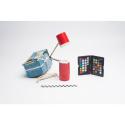Lamp
Classification(s):
Metal
Date: c.1951 -1976
Organisation: Lloyd's Electronics
Dimensions:
186 × 60 mm (18.6 × 6 cm)
Medium: Metal, platsic
Object number: M332N
See Also
Place of Production:Japan
Title:Lloyd-Lamp
DescriptionLloyd-Lamp “5 way high-intensity lamp” with original box, manufactured by Lloyd’s Electronics in Japan. The company Lloyd’s Electronics describe themselves on the box as “A new world of personal electronics”. The lamp is model number NA101, it takes a 12volt car bulb (no.93). The lamp is red and has a hinged arm, allowing the user to direct the light from the lamp head. It has a “lo” and “hi” light level function, controlled by turning the white disk on the lamp base. The lamp can be used in a fully closed position, where the light radiates through the band of translucent plastic at the rim of the lamp head. The lamp has its original power lead but no plug head.
The lamp has been labelled twice – “M332N” is scratched to the base, there is a second number “M333G” on a label stuck to the base. The same appears on the box, “M332N” is written onto the box; there is a second number “M333G” on a label stuck to the box.
The lamp has been labelled twice – “M332N” is scratched to the base, there is a second number “M333G” on a label stuck to the base. The same appears on the box, “M332N” is written onto the box; there is a second number “M333G” on a label stuck to the box.
ProvenanceThis object was originally acquired for the Inner London Education Authority’s (ILEA) ‘Circulating Design Scheme’ collection.
The collection was instigated by the London Country Council (later the Greater London Council) and the Council of Industrial Design (COID). The collection’s original purpose was concerned with the teaching and dissemination of modern, ‘good design’.
The collection was established in 1951/52 as the ‘Experiment in Design Appreciation’, later renamed the ‘Circulating Design Scheme’.
The Circulating Design Scheme lent boxed showcases to London schools. The showcases contained handling objects, material samples and interpretation on a specific subject.
COID withdrew its involvement in the Scheme in 1957. After which time, it was managed exclusively by the London County Council from 1957-1963.
After the administrative restructuring of London authorities, the Scheme was jointly managed by the Greater London Council and the Inner London Education Authority (ILEA) from 1963 – 1976.
The Scheme was operational until 1976 when the collections were withdrawn from circulation. ILEA was abolished in the late 1980s and the collection was donated to Camberwell College of Arts in 1989/90.
ILEA was responsible for secondary and tertiary education in the inner London boroughs, this included Camberwell.
The collection was instigated by the London Country Council (later the Greater London Council) and the Council of Industrial Design (COID). The collection’s original purpose was concerned with the teaching and dissemination of modern, ‘good design’.
The collection was established in 1951/52 as the ‘Experiment in Design Appreciation’, later renamed the ‘Circulating Design Scheme’.
The Circulating Design Scheme lent boxed showcases to London schools. The showcases contained handling objects, material samples and interpretation on a specific subject.
COID withdrew its involvement in the Scheme in 1957. After which time, it was managed exclusively by the London County Council from 1957-1963.
After the administrative restructuring of London authorities, the Scheme was jointly managed by the Greater London Council and the Inner London Education Authority (ILEA) from 1963 – 1976.
The Scheme was operational until 1976 when the collections were withdrawn from circulation. ILEA was abolished in the late 1980s and the collection was donated to Camberwell College of Arts in 1989/90.
ILEA was responsible for secondary and tertiary education in the inner London boroughs, this included Camberwell.



